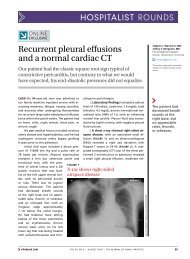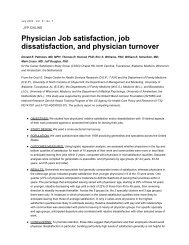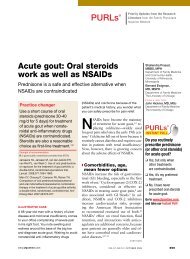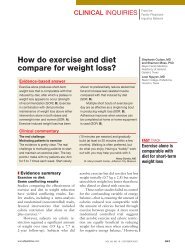Clinical Inquiries - The Journal of Family Practice
Clinical Inquiries - The Journal of Family Practice
Clinical Inquiries - The Journal of Family Practice
Create successful ePaper yourself
Turn your PDF publications into a flip-book with our unique Google optimized e-Paper software.
cognitive behavioral therapy—when compared<br />
with control patients on self-reported symptoms<br />
and knowledge. 7 <strong>The</strong> exercise and education<br />
group was also better than the control patients in<br />
self-reported daily functioning.<br />
We identified 2 additional trials examining<br />
different types <strong>of</strong> physical therapy for fibromyalgia<br />
that did not include control groups. In a trial<br />
<strong>of</strong> muscle strengthening vs flexibility training,<br />
investigators found no difference between groups<br />
on measures including tender points and disease<br />
and symptom severity. 8 <strong>The</strong>y did find benefits in<br />
symptoms and self-efficacy over baseline, but it<br />
is not known whether these were sustained.<br />
In a trial comparing 2 physical therapies—<br />
body awareness therapy and the Mensendieck<br />
system—Kendall and colleagues 9 found greater<br />
improvements at 18-month follow-up in the<br />
Mensendieck group. 9 Benefits were seen on<br />
the Fibromyalgia Impact Questionnaire, selfefficacy<br />
measures, and pain at worst site. <strong>The</strong><br />
Mensendieck system uses individual interview,<br />
analysis <strong>of</strong> movement patterns, a discussion <strong>of</strong><br />
possible corrections followed by practice, and<br />
relaxation exercises.<br />
Multidisciplinary rehabilitation, <strong>of</strong>ten including<br />
physical therapy, has also been studied in a<br />
limited way. In a systematic review <strong>of</strong> 7 studies<br />
fulfilling inclusion criteria (a total <strong>of</strong> 1050<br />
patients), Karjalainen and colleagues 10 concluded<br />
that although education combined with physical<br />
training seemed to have some positive results at<br />
long-term follow-up, the level <strong>of</strong> scientific evidence<br />
required for recommending these programs<br />
for fibromyalgia was lacking. 10<br />
Because exercise is believed to be an essential<br />
component <strong>of</strong> physical therapy, we examined the<br />
results <strong>of</strong> a systematic review <strong>of</strong> exercise for treating<br />
fibromyalgia. <strong>The</strong> authors found 7 high-quality<br />
studies, 4 <strong>of</strong> aerobic training, and concluded that<br />
supervised aerobic exercise training had beneficial<br />
effects on physical capacity, tender-point threshold,<br />
and pain. 11 Other investigators have questioned the<br />
usefulness <strong>of</strong> aerobic exercise because long-term<br />
benefit remains unclear and compliance is poor.<br />
718 SEPTEMBER 2003 / VOL 52, NO 9 · <strong>The</strong> <strong>Journal</strong> <strong>of</strong> <strong>Family</strong> <strong>Practice</strong><br />
CLINICAL INQUIRIES<br />
■ RECOMMENDATIONS FROM OTHERS<br />
We were unable to find any guidelines for the<br />
treatment <strong>of</strong> fibromyalgia. Patient information<br />
sheets from both the American College <strong>of</strong><br />
Rheumatology (www.rheumatology.org) and<br />
American Academy <strong>of</strong> Orthopaedic Surgeons<br />
(orthoinfo.aaos.org) recommend physical modalities<br />
such as heat application, massage, and<br />
exercise, including fitness training.<br />
Authors <strong>of</strong> chapters on fibromyalgia in both<br />
Kelly’s Textbook <strong>of</strong> Rheumatology and Harrison’s<br />
Principles <strong>of</strong> Internal Medicine suggest that<br />
patients may benefit from regular low-impact<br />
aerobic exercise. 12,13<br />
Mindy Smith, MD, MS, Michigan State University<br />
College <strong>of</strong> Human Medicine, East Lansing; Radha Ramana<br />
Murthy Gokula, MD, Sparrow/Michigan State University<br />
<strong>Family</strong> <strong>Practice</strong> Residency Program, Lansing;<br />
Arlene Weismantel, MILS, AHIP, Michigan State<br />
University Libraries, East Lansing<br />
■ CLINICAL COMMENTARY<br />
Exercise, physical therapy ease pain,<br />
“helplessness”<br />
Fibromyalgia is a disease <strong>of</strong> chronic pain. It<br />
engenders feelings <strong>of</strong> helplessness, depression,<br />
and loss <strong>of</strong> control in many patients. In<br />
my experience, both physical therapy and<br />
exercise can help alleviate these feelings.<br />
Physical therapy helps motivated patients perform<br />
body movements that they believe may be<br />
painful. In this sense, it demonstrates to them<br />
the possibility <strong>of</strong> exercising without excruciating<br />
pain. As the evidence suggests, patients<br />
who exercise have less pain and feel better in<br />
general. Thus, physical therapy can teach<br />
patients to actively participate in the management<br />
<strong>of</strong> their disease.<br />
Wail Malaty, MD, Mountain Area Health Education<br />
Center, Rural Track <strong>Family</strong> <strong>Practice</strong> Residency,<br />
Hendersonville, NC, Department <strong>of</strong> <strong>Family</strong> Medicine,<br />
University <strong>of</strong> North Carolina, Chapel Hill<br />
REFERENCES<br />
1. Guccione AA. Physical therapy for musculoskeletal syndromes.<br />
Rheum Dis Clin North Am 1996; 22:551–562.








